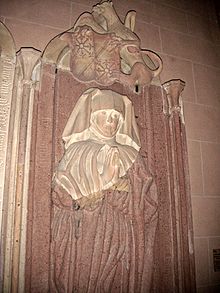Friedrich von Greiffenclau
Friedrich von Greiffenclau zu Vollrads (born March 8, 1401 probably at Schloss Vollrads , Oestrich-Winkel , † 1462 on the island Daksa near Dubrovnik ) was a German knight from the Greiffenclau dynasty and became a Franciscan widower .
origin
He came from the old noble family von Greiffenclau, who lived in Winkel (Rheingau) and initially had their seat there in the Gray House and from the beginning of the 14th century on Schloss Vollrads .
Friedrich von Greiffenclau zu Vollrads was the son of his father of the same name († 1419) and his wife Irmgard von Ippelbrunn († 1425), heir to their family estates in Eppelborn (= Ippelbrunn) in Saarland , in Schiffweiler and in Sinnerthal . Their descendants wore a coat of arms of the Greiffenclau that was augmented by the Ippelbrunn family coat of arms.
His brother Heinrich von Greiffenclau, dean of the cathedral in Mainz and Trier, resigned his office in 1456 and became a monk in the Birgittenkloster Marienforst near Bonn , where he died in 1462.
The sister Isengart von Greiffenclau zu Vollrads was abbess in Marienberg zu Boppard monastery , is considered its reformer and died there in 1469, with a reputation for holiness. Elisabeth, another sister, had married Friedrich von Löwenstein zu Randeck († 1450), the Electoral Palatinate bailiff in Bad Kreuznach . His grave slab is preserved there in the Pauluskirche .
Family and offspring
In 1418 he married Adelheid von Langenau († 1453), with whom he had at least 7 children.
The son Johann , Kurmainzer Vizedom of the Rheingau , inherited the property there and married Clara von Rathsamhausen; her son Richard von Greiffenklau zu Vollrads (1467–1531) became archbishop and elector of Trier.
Friedrich, the second son, took over ownership of the Saar and became lord of Eppelborn. He married Katharina von Elter (Autel) and they are the grandparents of Trier Elector Johann IV. Ludwig von Hagen .
The daughter Gertrud († 1502) married the court marshal of the Palatinate, Wolfgang III. Chamberlain of Worms , called von Dalberg, (1426–1476) and her or her husband's artistic epitaphs have been preserved in the Katharinenkirche Oppenheim . Both are the parents of the famous Bishop of Worms and Chancellor of the Electoral Palatinate, Johann XX. von Dalberg (1455–1503), as well as his brothers Friedrich VI. von Dalberg (1459–1506) and Wolfgang VI. von Dalberg (1473–1522).
The daughters Isengard, Christina and Margareta became religious; Christina Abbess and Isengard nun in the Marienberg monastery in Boppard , Margareta nun in the monastery Tiefenthal .
Life
When his mother died in 1425, Friedrich von Greiffenclau zu Vollrads inherited his parents' property in the Rheingau and on the Saar . In 1428 he fought against the Turks in the service of King Sigismund near Golubac . Here he saved the king from captivity and suffered a leg wound, which is why he was knighted and accepted into the Dragon Order . Queen Barbara of Cilli rewarded him with a band that bore her coat of arms. In 1429 Greiffenclau was involved in the campaign against the city of Metz .
In 1453 Friedrich von Greiffenclau became Vollrad's widower and went on a pilgrimage to Rome and the Holy Land from 1454 to 1456 . On his return journey in 1456 he entered the monastery of St. Sabina on the island of Daksa near Dubrovnik as a Franciscan brother , where he died in 1462 (according to another source as early as 1459). His son-in-law Wolf II von Dalberg visited him there when he was making a pilgrimage to Jerusalem . In his Flersheim Chronicle , Bishop Philipp von Flersheim included three letters written by Frederick on his pilgrimage. In it he justified his entry into the order to the sons with the words that it was better for him to leave the world with caution than on the last day in a careless way .
literature
- Otto Waltz: The Flersheim Chronicle , Leipzig, 1874, pp. 6–32
- Franz Joseph Bodmann : Rheingauische Antiquities , 1st Department, Mainz, 1819, p. 319 and 320; (Digital scan)
Web links
- Friedrich von Greiffenclau zu Vollrads in the Saarland biographies
- Website on funerary monuments in the Katharinenkirche
- Genealogical website about the person
- Genealogical page about the family with details about the children
Individual evidence
- ^ Website on the history of Schiffweiler
- ↑ Heraldry website on the Greiffenclau family
- ^ Johann-Anton-Joseph Hansen: Treviris or Trierisches Archiv für Vaterlandskunde, initially within the boundaries of the former Archdiocese and the current Diocese of Trier , Volume 1, p. 230, Trier, 1840; (Digital scan)
- ^ Franz Joseph Bodmann: Rheingauische Alterthümer , 1st Department, Mainz, 1819, p. 320; (Digital scan)
- ↑ Website on the epitaph of Isengart von Greiffenclau zu Vollrads
- ^ Website of the grave slab in Bad Kreuznach
- ↑ Genealogical website about the son Johann von Greiffenclau
- ^ Genealogical website about the son Friedrich von Greiffenclau
- ^ Siegrid Düll: Die insschriften der Stadt Oppenheim , p. 47, Reichert Verlag, 1984, ISBN 3882261943 ; (Detail scan)
- ^ Heinz-Dieter Heimann: Communication with the ego: Signatures of self-testimony research on European examples from the 12th to 16th centuries , Verlag Winkler, 2004, p. 138, ISBN 3899110188 ; (Detail scan)
| personal data | |
|---|---|
| SURNAME | Greiffenclau, Friedrich von |
| ALTERNATIVE NAMES | Greiffenclau zu Vollrads, Friedrich von (full name) |
| BRIEF DESCRIPTION | German knight, as a widower Franciscan |
| DATE OF BIRTH | March 8, 1401 |
| PLACE OF BIRTH | uncertain: Schloss Vollrads , Oestrich-Winkel |
| DATE OF DEATH | 1462 |
| Place of death | Daksa Island near Dubrovnik |


